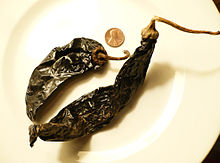

| Pasilla | |
|---|---|

Two pasilla chiles
| |
| Species | Capsicum annuum |
| Heat | |
| Scoville scale | 1,000–3,999 SHU |


The pasilla chile (/ˌpɑːˈsiːjə/ pah-SEE-yuh) or chile negro is the dried form of the chilaca chili pepper,[1] a long and narrow member of the species Capsicum annuum. Named for its dark, wrinkled skin (literally "little raisin"),[2] it is a mild to hot, rich-flavored chile. As dried, it is generally 6 to 8 inches (15 to 20 cm) long and 1 to 1+1⁄2 inches (2.5 to 3.8 cm) in diameter.
The fresh narrow chilaca can measure up to 9 inches (230 mm) long and often has a twisted shape, which is seldom apparent after drying. It turns from dark green to dark brown when fully mature.[3]
In the United States, producers and grocers sometimes incorrectly use "pasilla" to describe the poblano, a different, wider variety of pepper, the dried form of which is called an ancho.[4][5]
Pasilla are used especially in sauces. They are often combined with fruits and are excellent served with duck, seafood, lamb, mushrooms, garlic, fennel, honey, or oregano.[citation needed] They are sold whole or powdered in Mexico, the United States, and the United Kingdom.[citation needed]
Pasilla de Oaxaca is a variety of smoked pasilla chile from Oaxaca used in mole negro.[6]
Pasilla de Oaxaca: a variety of pasilla chile that is smoked in Oaxaca and is used in the famous mole negro.